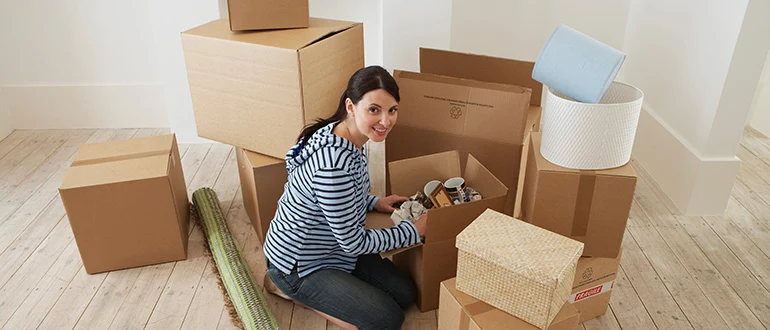
Packing tips when moving internationally
A move abroad is never an easy process. Thrilling as the very perspective of changing location may be, the effort you have to put into it may potentially dim the excitation. Although there is a world of difference between moving between towns within the shire and organising a full house removals to Germany or other foreign country in the European Union, both the tasks require a tactical approach to packing your belongings.
You may want to consider handling it all single handedly – if you can allocate the time and resources needed – or have it done for you by a qualified team. Let’s take a look at some packing tips when moving internationally. That will give some ideas on what it will require to tackle the operation on your own and how getting professional assistance might spare you the stress related to moving abroad and, in fact, save you some money in the process.
Before you pack the first box
 There’s no denying that what you pack and how you pack it will be to a large extent determined by where you’re moving to. Assuming you’re relocating to Germany to a semi-furnished, detached house in the south of Greece, dragging a bunch of heavy rugs and an old oak wardrobe may not be the best idea or anything that wouldn’t drain your pocket for that matter. You parking tip number one when moving internationally is practicality. What is it that you will really need that will not be either available or obtainable locally? Another point to consider is the quality of the goods. Sometimes selling your TV will be a better idea than having it transported overseas only to have to repurchase it in a short time.
There’s no denying that what you pack and how you pack it will be to a large extent determined by where you’re moving to. Assuming you’re relocating to Germany to a semi-furnished, detached house in the south of Greece, dragging a bunch of heavy rugs and an old oak wardrobe may not be the best idea or anything that wouldn’t drain your pocket for that matter. You parking tip number one when moving internationally is practicality. What is it that you will really need that will not be either available or obtainable locally? Another point to consider is the quality of the goods. Sometimes selling your TV will be a better idea than having it transported overseas only to have to repurchase it in a short time.
Bear in mind that moving from the UK to Germany in the post-Brexit reality will come with a lot of convoluted paperwork. After all, we are back to the import/export times where there are limitations and quotas on what you can ship overseas. To say nothing of customs clearance, duties and taxes. Therefore, before you pack the first box, you’ll have research the relevant legislation in the destination country.
Practice makes perfect. So, how many times have you moved home thus far? Most people will relocate once or twice in terms of major removals. Each time a different story, as things change. In any case, whether you’ll be moving to Germany only a portion of your belongings and home appliances or organising a full household removal abroad, there are challenges ahead. Logistics and legislation aside, the very process of packing a move abroad is a time-consuming job that will require some expenditures on the right packing materials to meet the requirements regarding international transportation and ensure safety of the belongings.
Get packing services from professional international removal company
Experienced removal teams are in abundance. The companies provide comprehensive solutions for domestic and international household removals. Hiring a firm is a very cost-effective approach in that you are offered a wide selection of options to choose from when it comes to the practical realisation of the moving job. Professional movers know the business well and have the right equipment to facilitate the operation. Here is what a standard offer includes:
- an in-house sales visit – a thorough assessment of the volume of work as well as calculation of the suitable loading space required for the removal
- packing and packaging – companies offer optional assistance in packing and packaging your belongings ready for transportation; their experience ensures safety and economy of space, which translates into lower overall costs
- packing materials – they’ve got all the materials and working solutions you can rely on during your move
- door-to-door/partial transportation – depending on your means, you will be able to order a direct delivery or partake in the process with your private means of transportation; many companies offer van rentals as an alternative
- customs duties and taxation – experienced movers will offer guidance on the legal aspects of your removal, providing and/or managing all the paperwork on your behalf
Relying on the experience of a professional removal company will surely have a massive unburdening effect on you. A second opinion on your removal plan – and one from a professional – will clear some of the uncertainties you may have regarding what to take and how to pack it. Your carries will readily supply you with professional packing materials that you would otherwise have to arrange yourself, often incurring significant extra expenditures. Taking part in the packing stage is an opportunity to pick up tricks of the trade, just in case you’ll have to move again. All in all, employing a professional company will ensure a smooth removal experience and often prove more cost-effective than if you were to go it alone.
Let’s pack!
First some preparations. Now that you know where you will be travelling and which items you will need in your new place, it would be wise to check the legal requirements on importable goods. Have a look at the relevant government webpages for the information on:
- customs duties and taxation
- import/export documentation
- banned items
 Moving out of the UK into any of the EU member states comes with a number of regulations, as the post-Brexit reality has complicated things a bit. Your belongings will have to be declared and cleared at customs both on their way out of the UK and into the Schengen zone or any other foreign country that is not bound by international agreements with the UK on the free flow of goods. Moving abroad permanently will entail residency issues. Transfer of Residency into the EU, for example, allows a duty-free import of personal belongings.
Moving out of the UK into any of the EU member states comes with a number of regulations, as the post-Brexit reality has complicated things a bit. Your belongings will have to be declared and cleared at customs both on their way out of the UK and into the Schengen zone or any other foreign country that is not bound by international agreements with the UK on the free flow of goods. Moving abroad permanently will entail residency issues. Transfer of Residency into the EU, for example, allows a duty-free import of personal belongings.
Importing goods into a foreign country requires a number of specific documents. Customs declaration will be one of them. So will be an itemised packing list of all your belongings. Research all the document requirements thoroughly before attempting exporting them abroad.
Each country has different regulations on the types and quantities of importable goods. Likewise, importing certain items will likely be either strictly controlled or downright banned. You will find the relevant information online.
Practical packing tips
Packing your downsized belongings will be a lot easier with a good plan at hand. Here are some good ideas on how to organise your belongings into manageable packagings.
Get the right packing materials
If you have opted out of a professional packing service, you’ll need to arrange the right packing materials yourself. There are countless online outlets offering a wide selection of secure packaging materials. For the most part, you will be fine with an assortment of cardboard boxes, tapes and some bubble wrap.
Spread the weight and fill the space
Heavy things should be put in smaller-size boxes. They’ll be easier to carry. Bigger boxes should be filled with more sizeable and lighter items e.g., pillows, bed covers, etc. Try putting heavier items on the bottom and fill the rest of the space with lighter things. Secure fragile items with bubble wrap and place them in between soft things, as you fill up boxes.
Tape the boxes and mark them
Once the boxes are packed to capacity, tape them around securely to prevent accidental opening in transport. The boxes should be marked clearly for their content and location, i.e., bedroom boxes, living room, bathroom. Orderliness is of importance. It will speed up customs clearance and facilitate unpacking.
Special items
Moving artwork or fragile items may require resorting to specialised packaging means. Consider reinforcing fragile surfaces with hardened materials. This will prevent breakages. Your mirrors and the TV screen will make it to your new location in one piece if you take extra care when packing them. Everyday electronic appliances should be packed in their original boxes. This ensures stability. If you chucked out the original boxes, consider custom crates for transporting fragile items.
Pack kitchen last, unpack it first
The trickiest bit is the kitchen. Do not skimp on paper and bubble wrap here. Put packing paper around every dish and stack them in bundles. Same with cups and glasses – each wrapped in paper separately from the other and stacked. If you have no access to boxes with cardboard divides for packing glasses and cups, fill the remaining space with bubble wrap to prevent breakages in transport.
Clothes
 Tightly roll your items of clothing. This way you can fit a lot of clothes into a box. Wrap shoes to prevent damage. Hanging clothes can be transported in a horizontal position or in a special transport stand.
Tightly roll your items of clothing. This way you can fit a lot of clothes into a box. Wrap shoes to prevent damage. Hanging clothes can be transported in a horizontal position or in a special transport stand.
Keep notes
It is important that you make a detail itemised list of all your belongings. This is also a requirement when clearing your shipment at customs. Your removal company will refuse to ship unitemised belongings.
Furniture
Dismantle what can be reassembled. This way it will be far more easily manageable and take up less space in the truck. Wrapping disassembled furniture in cardboard and taping it securely will prevent scratches and breakages. For fragile items, such as antique clockwork, consider custom transport services.
Loading the truck
Loading your belongings onto a truck is all about equally distributing the weight. Place the heavies elements in the centre and move them to the front of the vehicle. Lighter boxes should fill the remaining space on the sides ant towards the back. Strap the load securely inside the loading space.
Documents
Make sure you have all the documents containing personal information on you. You should not ship the following items in boxes:
- passports and IDs
- credit and debit cards
- legal tenders
